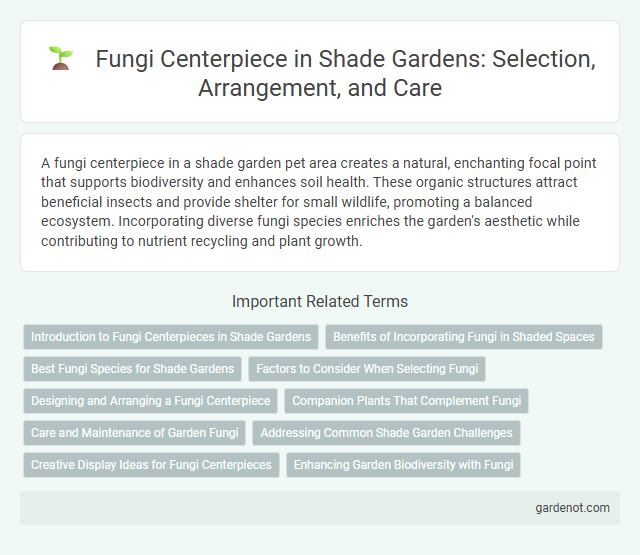A fungi centerpiece in a shade garden pet area creates a natural, enchanting focal point that supports biodiversity and enhances soil health. These organic structures attract beneficial insects and provide shelter for small wildlife, promoting a balanced ecosystem. Incorporating diverse fungi species enriches the garden's aesthetic while contributing to nutrient recycling and plant growth.
Introduction to Fungi Centerpieces in Shade Gardens
Fungi centerpieces in shade gardens create a natural focal point by showcasing diverse mushroom varieties adapted to low-light, moist environments. These fungi not only enhance the garden's aesthetic appeal but also support soil health through nutrient cycling and symbiotic relationships with tree roots. Selecting native fungi species ensures ecological balance while adding unique textures and colors to shaded garden spaces.
Benefits of Incorporating Fungi in Shaded Spaces
Incorporating fungi as a centerpiece in shade gardens enhances soil health by breaking down organic matter and releasing vital nutrients, promoting robust plant growth. Fungi establish symbiotic mycorrhizal relationships with plant roots, improving water absorption and resistance to environmental stress. Their presence supports biodiversity, attracting beneficial insects and contributing to a balanced, thriving shaded ecosystem.
Best Fungi Species for Shade Gardens
Oyster mushrooms (Pleurotus ostreatus) thrive in shade gardens, decomposing organic matter while adding visual interest with their delicate, fan-shaped caps. Turkey tail (Trametes versicolor) is another top choice, known for its vibrant, multicolored bands and ecological role in breaking down hardwood logs. Shiitake mushrooms (Lentinula edodes) also excel in shaded, moist environments, offering both aesthetic appeal and edible benefits in woodland gardens.
Factors to Consider When Selecting Fungi
Selecting fungi for a shade garden centerpiece requires careful consideration of moisture levels, as most shade-loving fungi thrive in consistently damp, well-drained soil enriched with organic matter. It's essential to match the fungi species to the local climate and shade intensity, ensuring they receive indirect sunlight and the right temperature range, typically between 55-70degF (13-21degC). Understanding the symbiotic relationships between fungi and surrounding plants can enhance soil health and garden biodiversity, making species like wood ear or turkey tail ideal for integration.
Designing and Arranging a Fungi Centerpiece
Designing and arranging a fungi centerpiece involves selecting diverse mushroom species with varied colors, shapes, and sizes to create a visually dynamic display. Incorporate natural elements like moss, wood, and leaf litter to mimic a forest floor and enhance the organic feel of the arrangement. Position fungi pieces at different heights and angles to highlight texture and form, emphasizing their unique ecological role in shade garden ecosystems.
Companion Plants That Complement Fungi
Companion plants such as ferns, hostas, and astilbes thrive in shade gardens and create a natural habitat that supports fungi growth by maintaining moist, shaded soil conditions. These plants contribute organic matter through decomposing leaves, enriching the soil and enhancing fungal networks. Incorporating shade-tolerant ground covers like ajuga or sweet woodruff further promotes a balanced ecosystem that complements fungi as a living centerpiece.
Care and Maintenance of Garden Fungi
Garden fungi in shade gardens require consistently moist, well-drained soil rich in organic matter to thrive. Regularly removing debris and dead plant material helps prevent fungal diseases and promotes healthy growth. Monitoring humidity levels and avoiding overwatering prevents mold and rot, ensuring vibrant, long-lasting fungi centerpieces.
Addressing Common Shade Garden Challenges
Fungi centerpieces thrive in the damp, low-light conditions typical of shade gardens, naturally addressing common problems like soil health and pest control. These organisms improve nutrient cycling by breaking down organic matter, enhancing soil fertility and structure. Integrating fungi in shade gardens supports plant growth, reduces decay, and creates a balanced ecosystem resistant to diseases.
Creative Display Ideas for Fungi Centerpieces
Incorporate diverse mushroom varieties like shiitake, oyster, and turkey tail to create a dynamic fungi centerpiece that thrives in low-light shade garden conditions. Utilize natural elements such as moss, bark, and leaf litter to enhance the organic aesthetic while supporting fungal growth. Arrange these components in tiered terrariums or hollowed logs to showcase textures and colors, providing a visually captivating and educational display.
Enhancing Garden Biodiversity with Fungi
Fungi play a crucial role in enhancing garden biodiversity by decomposing organic matter and enriching soil health, which supports a more vibrant shade garden ecosystem. Introducing a fungi centerpiece such as mycorrhizal mushrooms fosters symbiotic relationships with plant roots, improving nutrient uptake and resilience against pests. This natural biodiversity boost not only strengthens plant growth but also attracts beneficial insects and microorganisms essential for a balanced garden environment.
Fungi centerpiece Infographic

 gardenot.com
gardenot.com